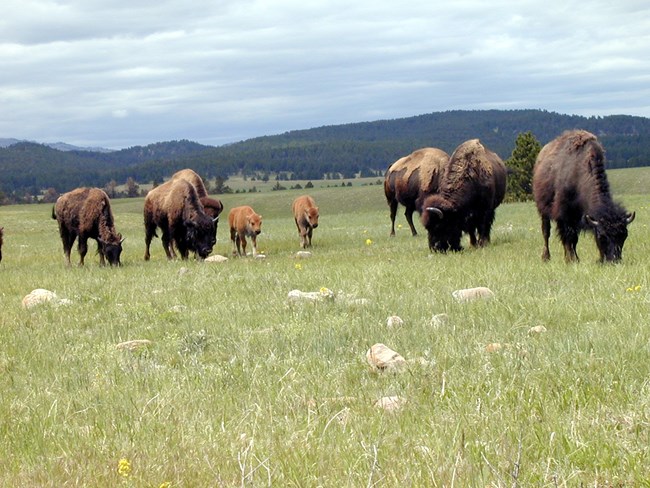Last updated: November 1, 2021
Article
Bison Bellows: A Healthy Prairie Relies on Bison Poop

NPS Photo.
Bison was one of the few really large herbivores to survive the Pleistocene extinctions and vast herds of these animals roamed the American prairies at the time of European contact. Bison grazing represents a well-studied dynamic process that interacts with complex landscapes to form disturbance patterns critical to many ecosystem functions. It is also known that bison behaviors such as trailing, wallowing, horning and trampling are important influences to plant and animal diversity. Yet, the full impact of the American Bison goes well beyond these more visible actions. Scientific discoveries have now identified important ecological effects from bison restroom behaviors.
One of the least shared impacts of bison on ecosystems is from deposition of buffalo dung or chips and urine on prairie soils. Every day, the average bison produces 10 to 12 quarts of dung and gallons of urine. Given there were as many as 60 million bison on the Great Plains one can only imagine the immense deposition of biological excreta on any day upon these grasslands. Both bison feces and urine when deposited are important sources of nitrogen, phosphorus, calcium, sulphur and magnesium for microbes, plants and other animals. This natural biologic function is a fundamental means of nutrient flow on the grasslands and woodlands across North America. Through bison excreta an entire population of micro-organisms and a rich insect community, including dung beetles and flies, are supported to help sustain a natural prairie.
The story of nutrient cycling through bison poop and pee begins in the rumen (the first chamber of the bison's four chambered digestion system) of the bison where the natural process of rumination (breaking down of food) recruits an entire microbial community to digest plant matter. These microbes, and undigested plant matter are passed through the bison gut and out onto the soil in feces and urine. Bison pies are elixirs of nutrients for the prairie, spreading seeds, fertilizing the soil, and attracting insects such as the dung beetle to the region. As many as 300 species of insects will live in one bison patty, and 1,000 individual insects will occupy that same patty from the time it's deposited to its removal. A single dung pat can produce up to 3000 flies over two weeks. Luckily for the box turtle, bats and many birds, more dung beetles and flies in the area means more meals for them as well. Bison dung and urine also provide a rich food supply essential to microorganisms found within soil. An entire, nearly invisible micro-ecosystem is fueled by the deposition of bison poop and pee.
Many dung beetles specialize on the dung of particular animals and simply will not touch the poo of other critters. Dung beetles have unique ways to decompose a bison patty. Tunneler and roller dung beetle species are especially important because they bury fresh manure below the soil surface, which places the nutrient rich dung directly in the soil and activates microbial activity that begins to break down the dung. The dung beetle is important in moving the nitrogen and carbon from the dung to adjacent soil, where it can be more easily decomposed by soil microorganisms. The nitrogen in the bison dung would not be accessible to plants if it was not first converted to ammonium by soil microbes, which is made easier by dung beetles. Recent studies have shown an increase in herbage growth in relation to the density of dung beetles which benefits many ungulate species such as elk and deer.
Dung beetle populations have declined in many areas following the introduction of livestock because they cannot find the appropriate dung. This has reduced the ability of natural systems to cycle nutrients and decompose fecal matter and impacts the function of prairie ecosystems far into the future. To correct this situation some managers have begun reintroduced dung beetles to mitigate this system change. Aside from ecological function of bison patty's they provided another service to mankind. Imagine traveling across the great oceans of grass in North America, where trees are not abundant, and there is no fuel for a fire for warmth and cooking. The novel solution was found in burning dried bison patties for cooking and warmth, as humans have done for thousands of years while traveling across these open prairies. The full story of bison poop in serving ecosystems and mankind is often not shared in modern history books, yet science has shown that this simple biological act may be one of the most curious bathroom stories in the world.
